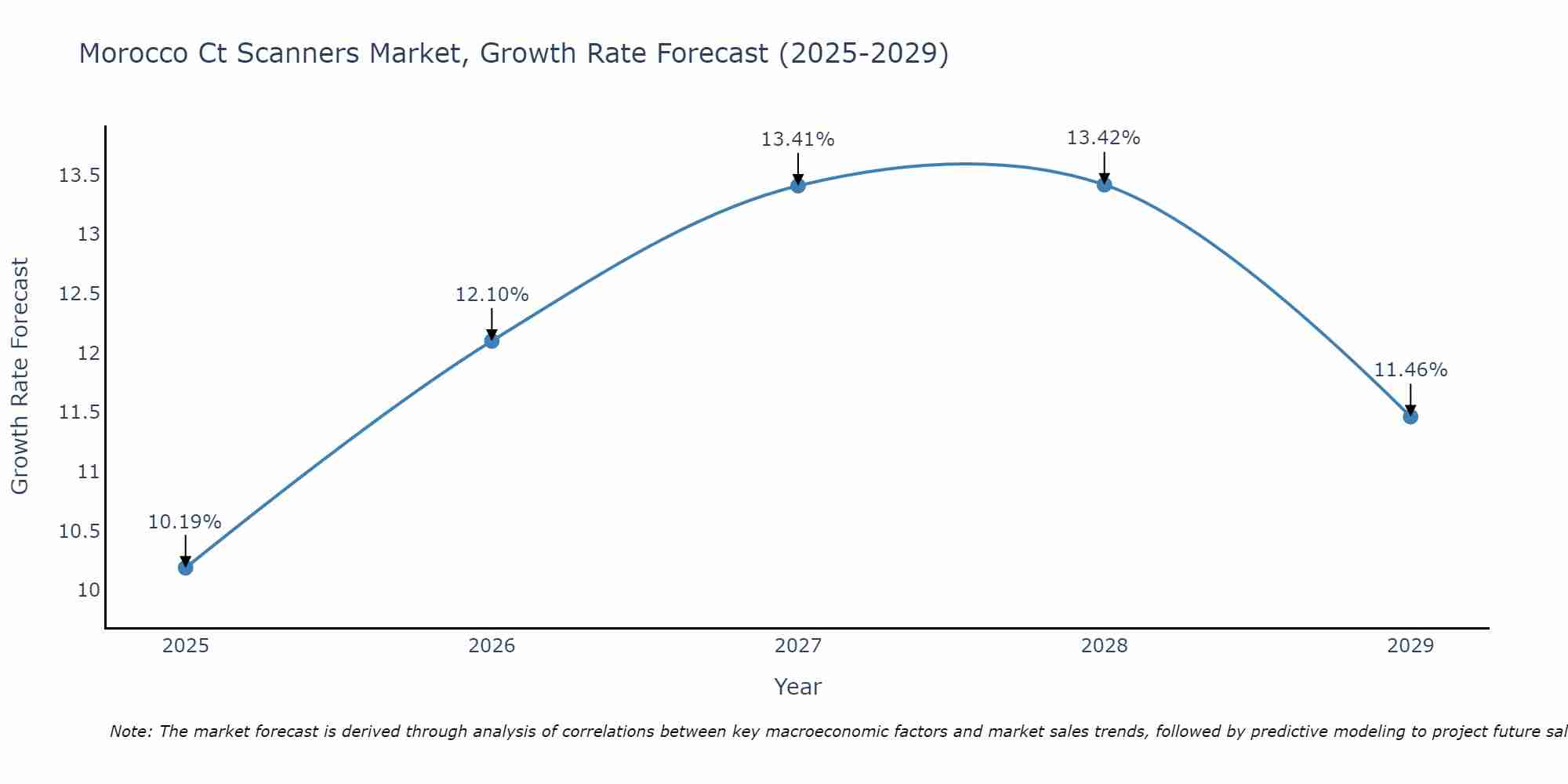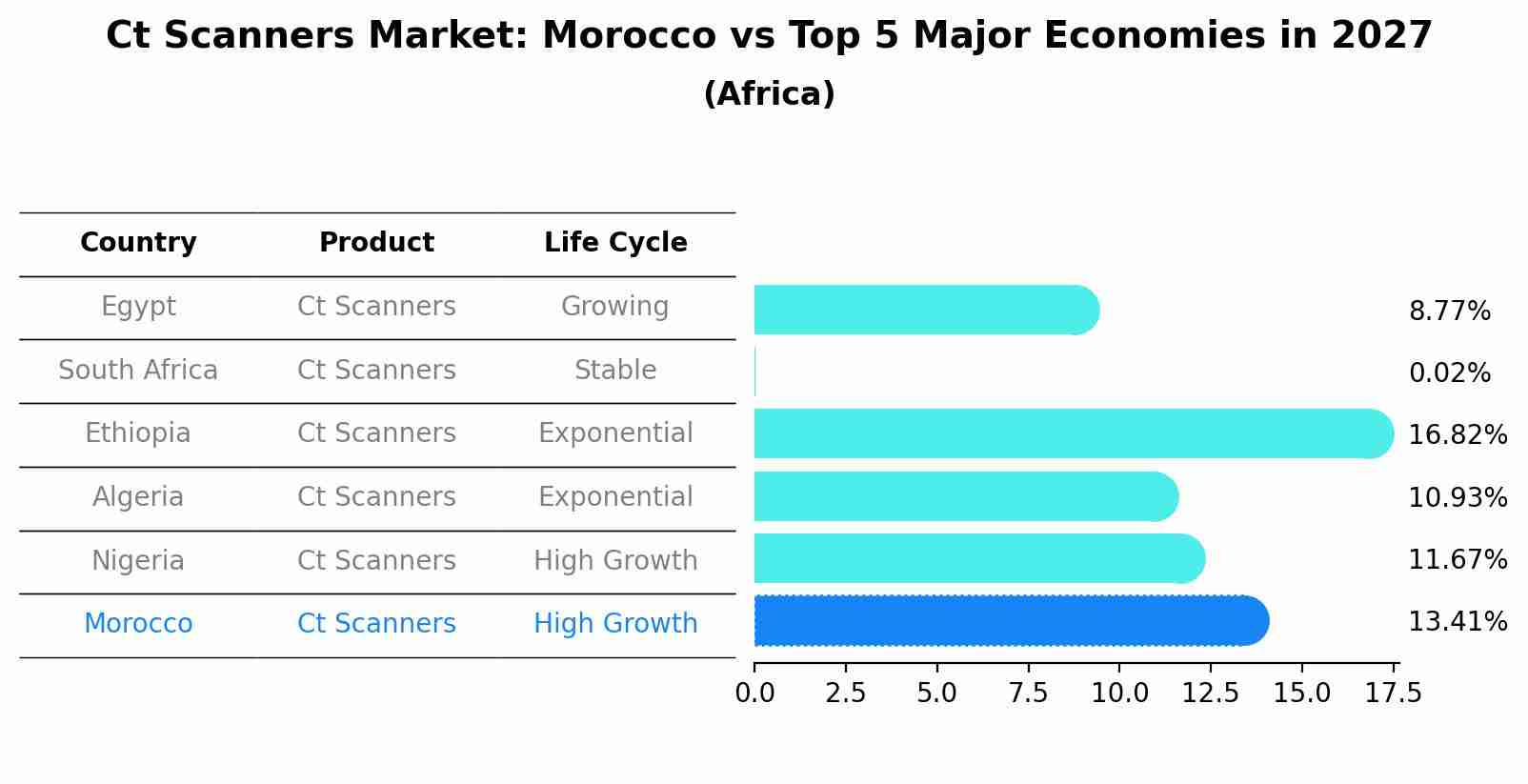Morocco Ct Scanners Market (2025-2031) Outlook | Trends, Value, Companies, Share, Growth, Size, Industry, Forecast, Revenue & Analysis
| Product Code: ETC362813 | Publication Date: Aug 2022 | Updated Date: Aug 2025 | Product Type: Market Research Report | |
| Publisher: 6Wresearch | Author: Vasudha | No. of Pages: 75 | No. of Figures: 35 | No. of Tables: 20 |
Morocco Ct Scanners Market Size Growth Rate
The Morocco Ct Scanners Market is projected to witness mixed growth rate patterns during 2025 to 2029. The growth rate begins at 10.19% in 2025, climbs to a high of 13.42% in 2028, and moderates to 11.46% by 2029.

Ct Scanners Market: Morocco vs Top 5 Major Economies in 2027 (Africa)
By 2027, the Ct Scanners market in Morocco is anticipated to reach a growth rate of 13.41%, as part of an increasingly competitive Africa region, where Egypt remains at the forefront, supported by South Africa, Ethiopia, Algeria and Nigeria, driving innovations and market adoption across sectors.

Morocco Ct Scanners Market Synopsis
The Morocco CT scanners market is experiencing steady growth driven by increasing demand for advanced medical imaging technologies in the country`s healthcare sector. The market is characterized by the presence of both local and international players offering a range of CT scanner products to cater to the diverse needs of healthcare facilities. Factors such as rising prevalence of chronic diseases, government initiatives to improve healthcare infrastructure, and growing investments in medical technology are fueling market growth. Additionally, the adoption of innovative CT scanner technologies like portable and low-dose scanners is gaining traction in Morocco. With a focus on providing accurate diagnosis and improving patient outcomes, the CT scanners market in Morocco is poised for further expansion in the coming years.
Morocco Ct Scanners Market Trends
The current trends in the Morocco CT scanners market include a growing demand for advanced technology scanners with higher image resolution and faster scanning speeds to improve diagnostic accuracy and efficiency. There is also a shift towards portable and compact CT scanners to enable point-of-care imaging in remote or mobile healthcare settings. Integration of artificial intelligence (AI) and machine learning algorithms in CT scanners is gaining traction for automated image analysis and decision support. Additionally, there is an increasing focus on reducing radiation dose exposure during CT scans through dose optimization techniques and iterative reconstruction algorithms. The market is witnessing collaborations between medical device manufacturers and healthcare providers to enhance access to CT scanning services in both urban and rural areas across Morocco.
Morocco Ct Scanners Market Challenges
In the Morocco CT scanners market, some challenges include limited access to advanced technology and high costs associated with acquiring and maintaining CT scanners. The healthcare infrastructure in Morocco may not always support the latest CT scanner models, leading to a disparity in equipment availability across different regions. Additionally, the high initial investment and ongoing expenses for maintenance, training, and upgrades can be prohibitive for healthcare facilities with limited budgets. Moreover, regulatory hurdles, such as lengthy approval processes for importing medical equipment, can further impede market growth. Addressing these challenges will require collaboration between government bodies, healthcare providers, and industry stakeholders to improve technology access, affordability, and regulatory efficiency in the Morocco CT scanners market.
Morocco Ct Scanners Market Investment Opportunities
The Morocco CT scanners market presents promising investment opportunities due to the increasing demand for advanced medical imaging technologies in the country. Factors such as a growing population, rising prevalence of chronic diseases, and government initiatives to improve healthcare infrastructure are driving the market`s growth. Investing in the Morocco CT scanners market offers potential for significant returns as healthcare facilities seek to upgrade their diagnostic capabilities with state-of-the-art imaging equipment. Additionally, advancements in CT scanner technology, such as improved image quality, faster scanning times, and enhanced patient comfort, are further stimulating market demand. Investors can capitalize on this trend by partnering with leading CT scanner manufacturers, exploring distribution partnerships, or investing in healthcare facilities looking to expand their imaging services.
Jordan Agar Market Government Policies
The Moroccan government has implemented various policies to regulate and support the CT scanners market. These policies include import regulations to ensure the quality and safety of CT scanners entering the country, as well as pricing regulations to control the cost of these medical devices. Additionally, the government has been focusing on increasing access to healthcare services, which has led to a growing demand for CT scanners in Morocco. In line with this, the government has also been investing in healthcare infrastructure and technology to support the development of the healthcare sector, including the procurement of CT scanners for hospitals and healthcare facilities across the country. Overall, the government`s policies aim to promote the growth of the CT scanners market in Morocco while ensuring the quality and affordability of these medical devices for the population.
Morocco Ct Scanners Market Future Outlook
The future outlook for the Morocco CT scanners market appears promising, driven by factors such as increasing healthcare infrastructure investments, growing prevalence of chronic diseases, and a rising geriatric population. Technological advancements in CT scanner systems, such as improved image quality and faster scanning speeds, are also expected to fuel market growth. Additionally, the adoption of telemedicine and the increasing demand for early disease detection are likely to further boost the demand for CT scanners in Morocco. However, challenges such as high initial costs and budget constraints in the healthcare sector may hinder market expansion to some extent. Overall, the Morocco CT scanners market is projected to experience steady growth in the coming years, with opportunities for market players to innovate and expand their presence in the region.
Key Highlights of the Report:
- Morocco Ct Scanners Market Outlook
- Market Size of Morocco Ct Scanners Market, 2024
- Forecast of Morocco Ct Scanners Market, 2031
- Historical Data and Forecast of Morocco Ct Scanners Revenues & Volume for the Period 2021 - 2031
- Morocco Ct Scanners Market Trend Evolution
- Morocco Ct Scanners Market Drivers and Challenges
- Morocco Ct Scanners Price Trends
- Morocco Ct Scanners Porter's Five Forces
- Morocco Ct Scanners Industry Life Cycle
- Historical Data and Forecast of Morocco Ct Scanners Market Revenues & Volume By Type for the Period 2021 - 2031
- Historical Data and Forecast of Morocco Ct Scanners Market Revenues & Volume By Stationary CT scanners for the Period 2021 - 2031
- Historical Data and Forecast of Morocco Ct Scanners Market Revenues & Volume By Portable CT scanners for the Period 2021 - 2031
- Historical Data and Forecast of Morocco Ct Scanners Market Revenues & Volume By Device Architecture for the Period 2021 - 2031
- Historical Data and Forecast of Morocco Ct Scanners Market Revenues & Volume By C-arm CT Scanners for the Period 2021 - 2031
- Historical Data and Forecast of Morocco Ct Scanners Market Revenues & Volume By O-arm CT Scanners for the Period 2021 - 2031
- Historical Data and Forecast of Morocco Ct Scanners Market Revenues & Volume By Technology for the Period 2021 - 2031
- Historical Data and Forecast of Morocco Ct Scanners Market Revenues & Volume By High-slice CT for the Period 2021 - 2031
- Historical Data and Forecast of Morocco Ct Scanners Market Revenues & Volume By Mid-slice CT for the Period 2021 - 2031
- Historical Data and Forecast of Morocco Ct Scanners Market Revenues & Volume By Low-slice CT for the Period 2021 - 2031
- Historical Data and Forecast of Morocco Ct Scanners Market Revenues & Volume By Cone-beam CT for the Period 2021 - 2031
- Historical Data and Forecast of Morocco Ct Scanners Market Revenues & Volume By Application for the Period 2021 - 2031
- Historical Data and Forecast of Morocco Ct Scanners Market Revenues & Volume By Human Application for the Period 2021 - 2031
- Historical Data and Forecast of Morocco Ct Scanners Market Revenues & Volume By Diagnostic Applications for the Period 2021 - 2031
- Historical Data and Forecast of Morocco Ct Scanners Market Revenues & Volume By Cardiology Applications for the Period 2021 - 2031
- Historical Data and Forecast of Morocco Ct Scanners Market Revenues & Volume By Oncology Applications for the Period 2021 - 2031
- Historical Data and Forecast of Morocco Ct Scanners Market Revenues & Volume By Neurology Applications for the Period 2021 - 2031
- Historical Data and Forecast of Morocco Ct Scanners Market Revenues & Volume By Intraoperative Applications for the Period 2021 - 2031
- Historical Data and Forecast of Morocco Ct Scanners Market Revenues & Volume By Veterinary Application for the Period 2021 - 2031
- Historical Data and Forecast of Morocco Ct Scanners Market Revenues & Volume By Research Application for the Period 2021 - 2031
- Morocco Ct Scanners Import Export Trade Statistics
- Market Opportunity Assessment By Type
- Market Opportunity Assessment By Device Architecture
- Market Opportunity Assessment By Technology
- Market Opportunity Assessment By Application
- Morocco Ct Scanners Top Companies Market Share
- Morocco Ct Scanners Competitive Benchmarking By Technical and Operational Parameters
- Morocco Ct Scanners Company Profiles
- Morocco Ct Scanners Key Strategic Recommendations
Frequently Asked Questions About the Market Study (FAQs):
- Single User License$ 1,995
- Department License$ 2,400
- Site License$ 3,120
- Global License$ 3,795
Search
Thought Leadership and Analyst Meet
Our Clients
Related Reports
- Germany Breakfast Food Market (2026-2032) | Industry, Share, Growth, Size, Companies, Value, Analysis, Revenue, Trends, Forecast & Outlook
- Australia Briquette Market (2025-2031) | Growth, Size, Revenue, Forecast, Analysis, Trends, Value, Share, Industry & Companies
- Vietnam System Integrator Market (2025-2031) | Size, Companies, Analysis, Industry, Value, Forecast, Growth, Trends, Revenue & Share
- ASEAN and Thailand Brain Health Supplements Market (2025-2031) | Strategy, Consumer Insights, Analysis, Investment Trends, Opportunities, Growth, Size, Share, Industry, Revenue, Segments, Value, Segmentation, Supply, Forecast, Restraints, Outlook, Competition, Drivers, Trends, Demand, Pricing Analysis, Competitive, Strategic Insights, Companies, Challenges
- ASEAN Bearings Market (2025-2031) | Strategy, Consumer Insights, Analysis, Investment Trends, Opportunities, Growth, Size, Share, Industry, Revenue, Segments, Value, Segmentation, Supply, Forecast, Restraints, Outlook, Competition, Drivers, Trends, Demand, Pricing Analysis, Competitive, Strategic Insights, Companies, Challenges
- Europe Flooring Market (2025-2031) | Outlook, Share, Industry, Trends, Forecast, Companies, Revenue, Size, Analysis, Growth & Value
- Saudi Arabia Manlift Market (2025-2031) | Outlook, Size, Growth, Trends, Companies, Industry, Revenue, Value, Share, Forecast & Analysis
- Uganda Excavator, Crane, and Wheel Loaders Market (2025-2031) | Strategy, Consumer Insights, Analysis, Investment Trends, Opportunities, Growth, Size, Share, Industry, Revenue, Segments, Value, Segmentation, Supply, Forecast, Restraints, Outlook, Competition, Drivers, Trends, Demand, Pricing Analysis, Competitive, Strategic Insights, Companies, Challenges
- Rwanda Excavator, Crane, and Wheel Loaders Market (2025-2031) | Strategy, Consumer Insights, Analysis, Investment Trends, Opportunities, Growth, Size, Share, Industry, Revenue, Segments, Value, Segmentation, Supply, Forecast, Restraints, Outlook, Competition, Drivers, Trends, Demand, Pricing Analysis, Competitive, Strategic Insights, Companies, Challenges
- Kenya Excavator, Crane, and Wheel Loaders Market (2025-2031) | Strategy, Consumer Insights, Analysis, Investment Trends, Opportunities, Growth, Size, Share, Industry, Revenue, Segments, Value, Segmentation, Supply, Forecast, Restraints, Outlook, Competition, Drivers, Trends, Demand, Pricing Analysis, Competitive, Strategic Insights, Companies, Challenges
Industry Events and Analyst Meet
Whitepaper
- Middle East & Africa Commercial Security Market Click here to view more.
- Middle East & Africa Fire Safety Systems & Equipment Market Click here to view more.
- GCC Drone Market Click here to view more.
- Middle East Lighting Fixture Market Click here to view more.
- GCC Physical & Perimeter Security Market Click here to view more.
6WResearch In News
- Doha a strategic location for EV manufacturing hub: IPA Qatar
- Demand for luxury TVs surging in the GCC, says Samsung
- Empowering Growth: The Thriving Journey of Bangladesh’s Cable Industry
- Demand for luxury TVs surging in the GCC, says Samsung
- Video call with a traditional healer? Once unthinkable, it’s now common in South Africa
- Intelligent Buildings To Smooth GCC’s Path To Net Zero


















